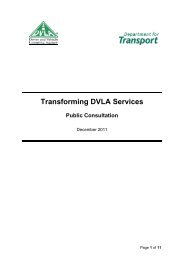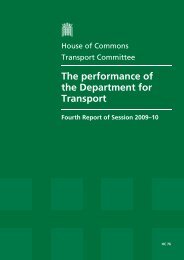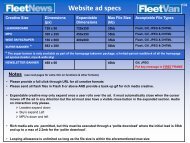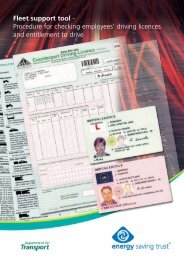Zurich Guide to Managing Grey Fleet Risks - Fleet News
Zurich Guide to Managing Grey Fleet Risks - Fleet News
Zurich Guide to Managing Grey Fleet Risks - Fleet News
You also want an ePaper? Increase the reach of your titles
YUMPU automatically turns print PDFs into web optimized ePapers that Google loves.
Why manage your grey fleet?<br />
Your Duty of Care<br />
The ‘Driving at work – managing workrelated<br />
road safety’ guidelines, published<br />
by the Department for Transport (DfT) and<br />
Health & Safety Executive (HSE) in 2003,<br />
make it clear that an organisation has<br />
the same Duty of Care <strong>to</strong>wards all its<br />
employees making work-related journeys<br />
regardless of vehicle ownership, so the<br />
grey fleet needs <strong>to</strong> be managed in exactly<br />
the same way as the owned or leased fleet.<br />
This, as you might expect, raises a number<br />
of challenges that we examine below.<br />
In practice, this means that the Health &<br />
Safety at Work Act, and all the relevant<br />
daughter legislation, applies <strong>to</strong> employees<br />
making work-related journeys, including<br />
the grey fleet, and that organisations<br />
need <strong>to</strong> manage the driving activities<br />
appropriately. This, <strong>to</strong>gether with the<br />
Association of Chief Police Officers (ACPO)<br />
Road Death Investigation Manual 2007 1 ,<br />
and the recent Corporate Manslaughter<br />
and Corporate Homicide Act 2007, mean<br />
that the police and the HSE have a<br />
selection of legislation that they can use<br />
whenever an organisation is suspected<br />
of being negligent in the management of<br />
its employees making work-related road<br />
journeys – typically after a serious collision<br />
has occurred.<br />
In reality, the chances of any investigation<br />
and prosecution are very low, but the<br />
consequences <strong>to</strong> the organisation,<br />
especially in terms of large fines and<br />
reputational damage, are very serious,<br />
so it is imperative that organisations have<br />
a robust set of policies and procedures<br />
<strong>to</strong>gether with a strong audit trail.<br />
The financial argument 2<br />
It is common <strong>to</strong> find fleet and risk<br />
managers focusing on the insured costs<br />
and easily identified uninsured costs, such<br />
as the ‘accidental damage’ (if this is not<br />
covered by their policy) and direct costs<br />
associated with any excess or deductible<br />
associated with their policy, as well as easy<br />
<strong>to</strong> measure issues such as hire costs.<br />
In terms of business impact, the ‘hidden’<br />
uninsured losses, such as those associated<br />
with absenteeism and reputational<br />
damage, are for more important.<br />
The International Loss Control Institute<br />
say that for every £1 paid out by an<br />
insurer, there are between £8.00 – £53.00<br />
in uninsured losses, depending on the<br />
severity of the incident.<br />
1<br />
For more information refer <strong>to</strong> Appendix 1 on p. 21.<br />
2<br />
For more information refer <strong>to</strong> Appendix 2 on p. 21.<br />
6









